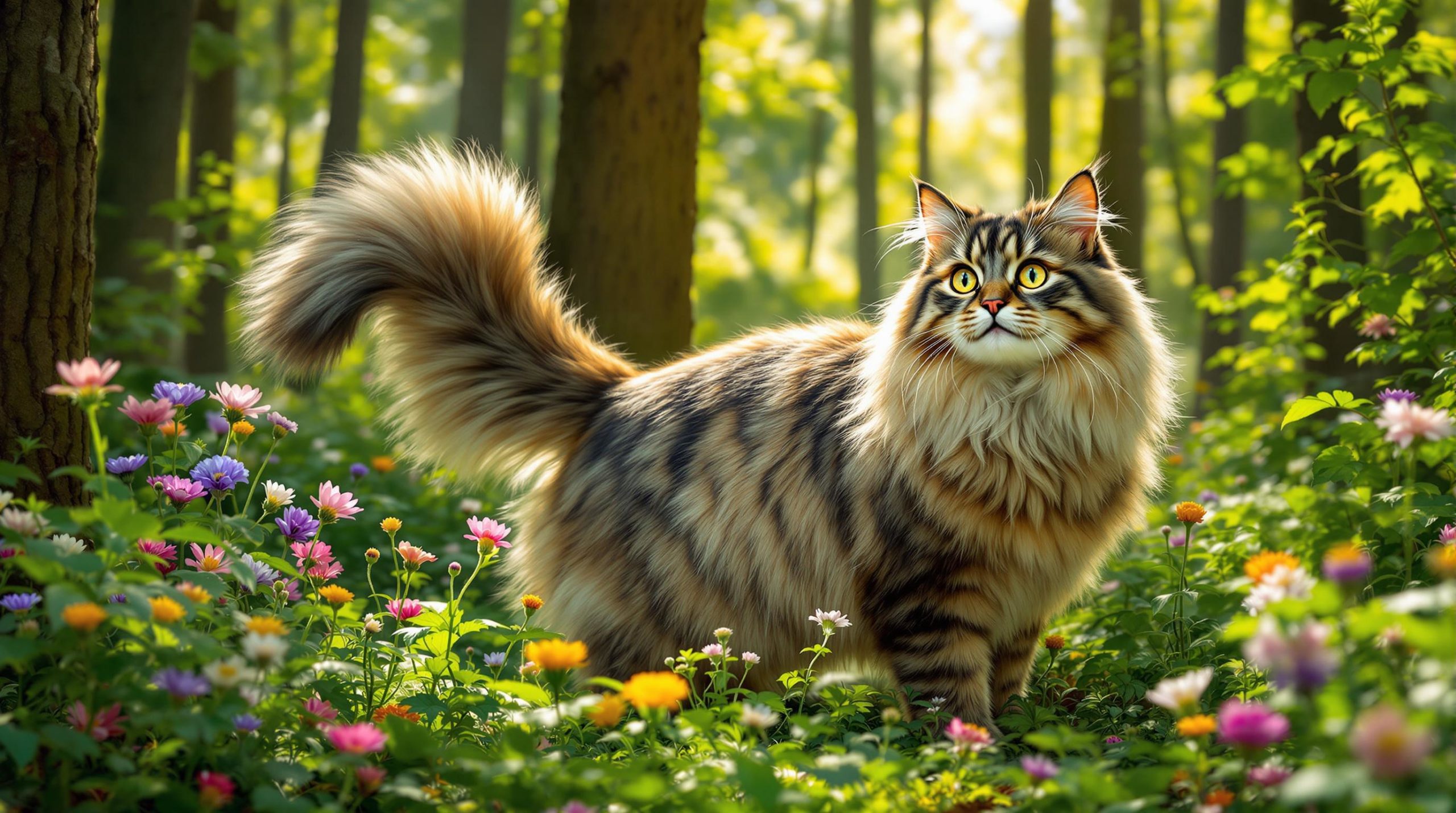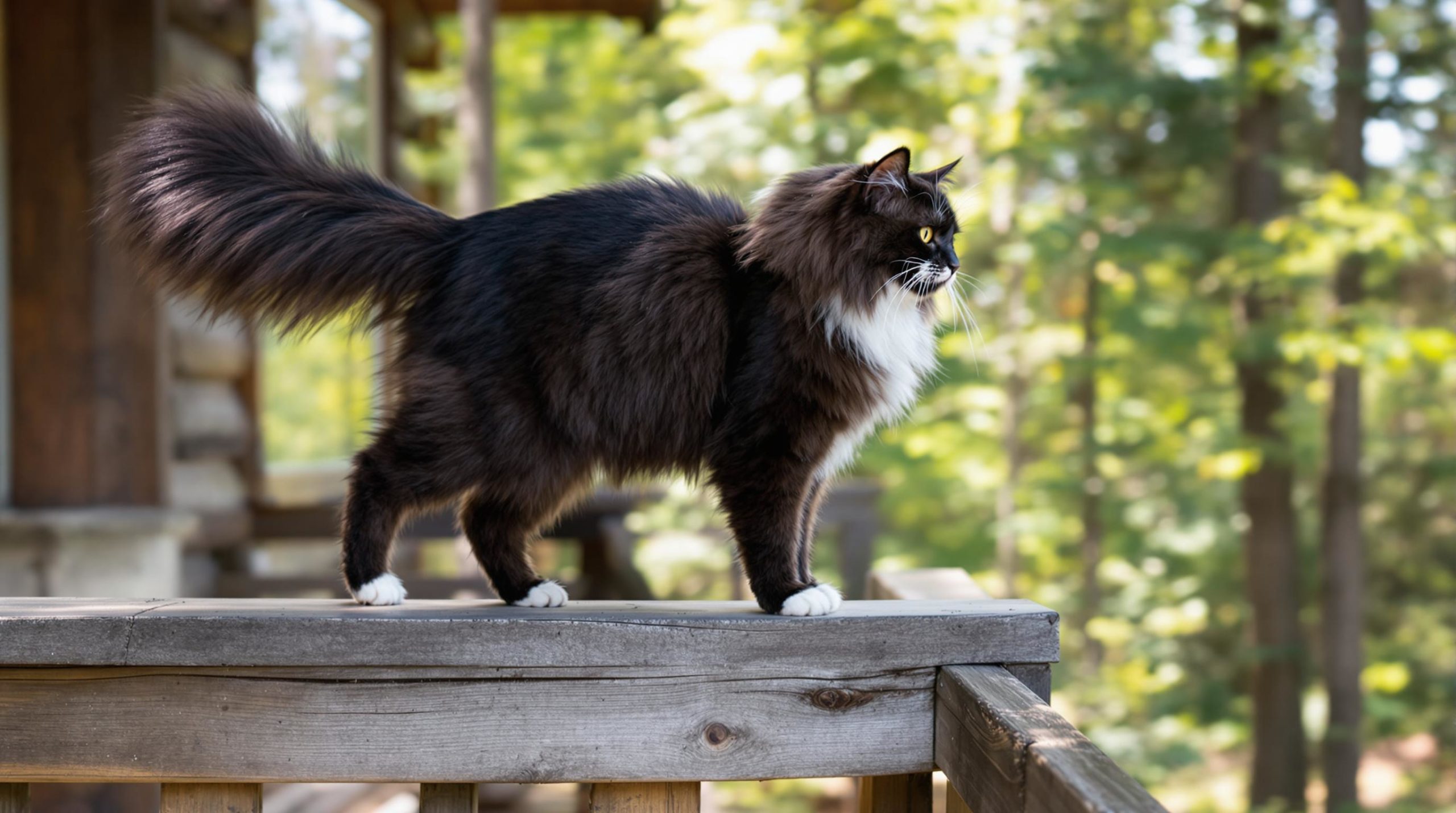exploring the intriguing reasons for the long tails of Maine Coons

The majestic Maine Coon is renowned not just for its large size but also for its impressively long and bushy tail, which sets it apart from other feline breeds. This tail, often measuring over a foot in length, isn’t just a show-off feature—it’s packed with purpose and charm. From aiding in their remarkable agility to serving as a warm blanket during harsh winters, the Maine Coon’s tail is a fascinating subject for any cat enthusiast eager to understand these gentle giants better. Today, we dive into the reasons behind the long tails of Maine Coons, unraveling their mysteries and exploring the tail’s critical roles in behavior, survival, and communication.
Understanding the Functional Role of Maine Coon Long Tails in Balance and Agility
When observing a Maine Coon in motion, it’s impossible to ignore how gracefully it navigates through tight spaces, climbs, or makes acrobatic leaps. Central to these movements is the tail, serving as a natural counterbalance. The length and bushiness of the tail effectively work as a dynamic stabilizer, allowing the Maine Coon to maintain equilibrium during quick turns and jumps.
Unlike smaller cat breeds, Maine Coons are notably larger, with some males weighing up to 18 pounds or more. This size demands enhanced balance to move with agility and precision. Their long tail, often constituting around 40% of their body length, essentially acts as a rudder steering their stylish moves.
- Counterbalance during jumps: As Maine Coons leap between surfaces, their tail twists and moves to offset the body’s momentum, preventing falls.
- Navigating narrow pathways: Their tail swings and adjusts subtly to keep the body aligned as they walk along fences or narrow ledges.
- Aerial adjustments: Mid-air, the tail corrects the body’s position for a soft, precise landing, similar to a tightrope walker’s pole.
In fact, some experts from the Maine Coon Cat Club have noted that without this long tail, the breed’s signature fluidity and poise would be compromised severely, impacting their mobility and confidence.
Interestingly, while cats with naturally shorter tails or those who have lost part of their tails still display impressive agility, the Maine Coon’s tail length vastly improves the degree to which they can perform complex movements. It’s a beautiful example of evolutionary adaptation shaped by their environment.
| Balance Function | Tail Movement Role | Effect on Agility |
|---|---|---|
| Jump Stability | Tail adjusts mid-air to counterweight body | Prevents tumbling upon landing, smooth landings |
| Navigating Narrow Spaces | Swaying tail fine-tunes balance | Keeps the body aligned on narrow surfaces |
| Directional Changes | Quick tail flicks alter body rotation | Makes agile turns and twists quick and safe |

The Winter Warrior: How Maine Coon Tails Serve as Warmth and Protection
Originating from the chilly state of Maine, these cats have adapted incredibly well to survive and thrive in cold climates. Their thick, luxurious tail is a critical heat retention tool that helps them combat harsh winter conditions.
Unlike many other breeds, Maine Coons possess long, thick fur which extends to their tails, providing a natural blanket of warmth. During the colder months, it’s common to see Maine Coons curling their tail around their bodies or even wrapping it around their faces for added insulation.
Key Reasons Maine Coon Tails Provide Warmth:
- Insulation Layer: The dense fur helps trap body heat, acting like a natural scarf.
- Protection from Elements: The tail shields sensitive body parts during wind and snow.
- Reducing Heat Loss: Curling their tail around helps reduce heat loss through extremities.
Veterinarians and breeders from groups like Feline Families and Whiskers and Wonders emphasize the importance of a healthy coat and tail for this reason. If a Maine Coon is kept strictly indoors (see indoor vs. outdoor preferences), the tail still plays a role in emotional comfort, mirroring the security function it serves in the wild.
It’s essential to maintain proper grooming to ensure that their tail’s fur doesn’t mat or tangle, which can impede its effectiveness at warmth. Long-haired tails can accumulate dirt or oils, occasionally leading to conditions like ‘stud tail,’ an oily buildup near the tail base. Owners are encouraged to watch for such signs and consult a vet for treatment options.
| Thermoregulation Factor | Tail Function | Benefit to Maine Coon |
|---|---|---|
| Cold Weather Adaptation | Bushy tail curls as insulation wrap | Keeps core temperature stable |
| Shield Against Elements | Protects vulnerable body parts | Preserves health in harsh conditions |
| Emotional Comfort | Tail wrapping mimics security | Reduces stress in indoor cats |
Decoding Maine Coon Tail Language: What Their Tail Tells Us About Their Emotions
Maine Coon cats, like all felines, communicate extensively with their tails. Because they cannot express themselves verbally, keen attention to tail posture and movement reveals a wealth of information about their moods and intentions.
This communication is so pronounced that organizations such as Tail Trail Treasures and the Cat Explorers Society have catalogued tail positions and their corresponding emotions to help owners decode their pet’s feelings accurately.
Common Maine Coon Tail Signals and Interpretations:
- Tail held high and erect: Confidence and happiness; a greeting sign signaling friendliness.
- Tail puffed up: Alarm or fear; the cat is trying to appear larger to ward off threats.
- Slow tail twitching: Curiosity or focused attention; often a precursor to play or hunting behavior.
- Rapid tail flicking: Irritation or mild annoyance; warns others to keep distance.
- Violent tail lashing: Anger or distress; best to give the cat space immediately.
Mastering this tail language is an enriching step in deepening the bond with your Maine Coon and understanding their unique personality traits. It’s worth noting that reading tail signals together with ear positions and body posture offers the best insight.
| Tail Movement | Emotional Indication | Owner Action |
|---|---|---|
| High, curved tail | Happy, welcoming | Approach & greet warmly |
| Puffed tail | Fearful, defensive | Provide space, avoid interaction |
| Twitching tail | Playful, curious | Engage in gentle play |
| Rapid flicking | Irritated | Back off slowly |
| Lashing | Angry | Give immediate space |
Growth Patterns and Genetic Mysteries Behind Maine Coon Long Tails
While Maine Coons are famous for their grandeur, their tails grow slowly and continue developing until the cat reaches full physical maturity, typically between 3 and 5 years of age. This prolonged growth phase contributes to the tail’s impressive length and luxurious fur density.
One of the largest Maine Coons ever recorded, named Stewie, had a tail measuring approximately 16.3 inches — a length that astonished many cat enthusiasts and earned him a place in feline history. Such extremes highlight the fascinating genetic factors that make Maine Coon tails unique.
Several intriguing genetic elements influence this tail length. For example, some cats possess a hypermobile tail, a rare feature where the tail is so flexible it can curl over their back or even touch their ears — a trait occasionally seen in Maine Coons.
- Slow growth rate: Maine Coons don’t reach full tail length quickly, growing steadily over years.
- Genetic predisposition: Breeders from Maine Coons Unlimited monitor lineage carefully to maintain these signature tail traits.
- Tail flexibility variations: Hypermobile tails are especially prized but require gentle care to avoid injury.
If you have a young Maine Coon kitten, it’s normal to see a less pronounced tail initially. Owners should be patient, allowing the cat’s tail to mature naturally as part of their overall development. For more on Maine Coon care and exercise requirements, visiting trusted resources like Curious Cat Co. can provide valuable guidance.
| Growth Phase | Typical Tail Length | Genetic Factors |
|---|---|---|
| Kitten (up to 1 year) | Shorter, less dense fur | Rapid body growth starts but tail grows slowly |
| Juvenile (1-3 years) | Lengthening with thicker fur | Genetic expression of tail features increasing |
| Adult (3-5 years) | Full length and bushiness achieved | Genetic tail characteristics fully expressed |

Common Care Tips for Maintaining the Health and Beauty of Maine Coon Tails
Keeping a Maine Coon’s tail in pristine condition requires attention and effort but yields great rewards for both cat and owner. Regular grooming, observation for skin or fur issues, and understanding tail-related behaviors ensure that your Maine Coon’s tail remains a source of pride.
Here are useful tips from the Fur High Society and other feline enthusiast groups on tail care:
- Regular brushing: Helps prevent mats and tangles, especially important for the dense fur of Maine Coons.
- Frequent inspection: Check for oily buildup or skin irritations, such as ‘stud tail,’ which requires veterinary care.
- Tail-friendly handling: Avoid pulling or harsh grooming that can harm delicate tail bones or fur.
- Monitor for injuries: Maine Coons’ active lifestyle can sometimes cause tail injuries; early detection is key.
- Maintain overall health: A well-balanced diet and adequate exercise (source) support healthy fur growth and strength.
It’s also essential to provide environmental enrichment and a calm atmosphere to reduce tail-related anxieties or behavioral issues. For example, if your Maine Coon hisses or lashes its tail frequently during interactions, consider modifying your approach or offering more personal space to your feline friend.
| Care Measure | Action | Benefit |
|---|---|---|
| Brushing | Use soft brush weekly | Prevents tangles and mats |
| Inspection | Check tail base for oiliness | Early detection of skin issues |
| Handling | Gentle, avoid rough tugging | Protects tail bones and fur |
| Exercise | Regular play sessions | Supports muscle and fur health |
| Environment | Safe, calm surrounding | Reduces stress and destructive behaviors |
FAQ on Maine Coon Tails and Their Unique Characteristics
| Q: How long can a Maine Coon’s tail get? | A: Typically, Maine Coon tails range between 11 to over 16 inches, with some record-breaking individuals like Stewie reaching lengths over 16 inches. |
| Q: Why do Maine Coons have bushier tails than other cats? | A: Their tails have thick, long fur to offer warmth and protection from cold climates, a feature naturally developed due to their Maine origins. |
| Q: What does it mean when a Maine Coon licks or vibrates its tail? | A: Tail vibrations can indicate excitement, anxiety, or even frustration. Observing the overall body language helps interpret the cat’s mood accurately. |
| Q: Can tail length in Maine Coons indicate health or lineage? | A: While tail length is mostly genetic, extremely short or thin tails may signal health issues or mixed lineage. Breeders from Maine Coons Unlimited carefully select for tail quality in their breeding programs. |
| Q: How can I care for my Maine Coon’s tail to prevent problems like stud tail? | A: Maintain regular grooming, inspect for greasy buildup, and consult a veterinarian promptly. Effective grooming avoids many skin problems common in bushy tails. |